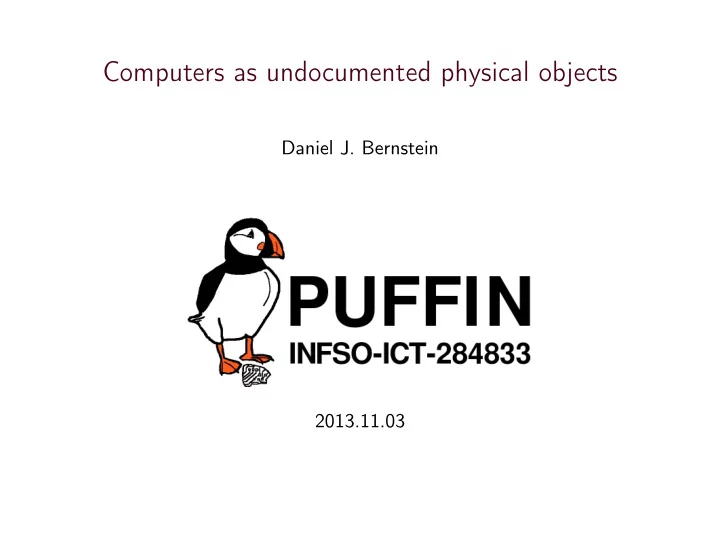

Computers as undocumented physical objects Daniel J. Bernstein 2013.11.03
Do you think you understand how a computer behaves? Conventional software engineering: Yes, we do! We build programs purely from documented features of chips. The chips compute exactly what the documentation says. Computers as undocumented physical objects 2
Do you think you understand how a computer behaves? Conventional software engineering: Yes, we do! We build programs purely from documented features of chips. The chips compute exactly what the documentation says. Or do they? Let’s try some examples: ◮ Suppose you run a CPU above its rated speed. What does it compute? This is “overclocking”. Important for performance. Computers as undocumented physical objects 2
Do you think you understand how a computer behaves? Conventional software engineering: Yes, we do! We build programs purely from documented features of chips. The chips compute exactly what the documentation says. Or do they? Let’s try some examples: ◮ Suppose you run a CPU above its rated speed. What does it compute? This is “overclocking”. Important for performance. ◮ Suppose you fire a small laser at the CPU. What does the CPU compute? This is a “fault attack”. Important for security. Computers as undocumented physical objects 2
Do you think you understand how a computer behaves? Conventional software engineering: Yes, we do! We build programs purely from documented features of chips. The chips compute exactly what the documentation says. Or do they? Let’s try some examples: ◮ Suppose you run a CPU above its rated speed. What does it compute? This is “overclocking”. Important for performance. ◮ Suppose you fire a small laser at the CPU. What does the CPU compute? This is a “fault attack”. Important for security. ◮ Suppose you watch the CPU’s electromagnetic emissions. What do you see? This is a “side-channel attack”. Important for security. Computers as undocumented physical objects 2
Chip-specific programming DDI0388E_cortex_a9_r2p0_trm.pdf page 126 says “You must invalidate the instruction cache, the data cache, and BTAC before using them.” Conventional software engineering: Zu Befehl! We will invalidate these caches before using them. Computers as undocumented physical objects 3
Chip-specific programming DDI0388E_cortex_a9_r2p0_trm.pdf page 126 says “You must invalidate the instruction cache, the data cache, and BTAC before using them.” Conventional software engineering: Zu Befehl! We will invalidate these caches before using them. Exercise: What if we don’t invalidate, e.g., the data cache? Can we read the power-on state of the cache SRAM? Power-on state will vary across “identical” Cortex-A9 cores. Useful for fingerprinting? Fancier security applications? Computers as undocumented physical objects 3
PUFFIN begins Eurocrypt 2010 lunchtime conversation between Helena Handschuh (Intrinsic-ID), Tanja Lange (Technische Universiteit Eindhoven), Daniel J. Bernstein (University of Illinois at Chicago): IID, paraphrased: You’ve been doing all this work with GPUs. Can you read the power-on contents of SRAM from GPUs? Answer: We should be able to. GPU machine language can directly access “shared memory”, which from performance characteristics is clearly SRAM. ⇒ Initial experiments: GPU hardware is obviously not clearing the SRAM. Dangerous for security: Don’t store secret data on GPUs! But maybe this is also something we can use for security. Computers as undocumented physical objects 4
PUFFIN today “Physically unclonable functions found in standard PC components.” EU FP7 project INFSO-ICT-284833; started in 2012. Partners: ◮ TUE: Technische Universiteit Eindhoven, Netherlands (coordinator) ◮ IID: Intrinsic-ID, Netherlands ◮ KUL: Katholieke Universiteit Leuven, Belgium ◮ TUD: Technische Universität Darmstadt, Germany Research work packages: ◮ WP1, leader TUE, co-leader KUL: Exploration ◮ WP2, leader IID: Analysis and qualification ◮ WP3, leader TUD: Use cases Project manager: Tanja Lange, TUE. Scientific manager: Pim Tuyls, IID. Computers as undocumented physical objects 5
Example of successful exploration: microcontrollers Custom PCB with several STM32F100R8 microcontrollers (ARM Cortex-M3 cores) and measurement board. Designed and built by Anthony Van Herrewege (KUL). ⇒ Successful extraction of chip-specific data. Computers as undocumented physical objects 6
More examples of successful exploration Daniel J. Bernstein and Tanja Lange (TUE): Chip-specific data from GTX 295 graphics cards. André Schaller (TUD): Chip-specific data from TI PandaBoard. Same chips used in many TI smartphones. Computers as undocumented physical objects 7
Recommend
More recommend